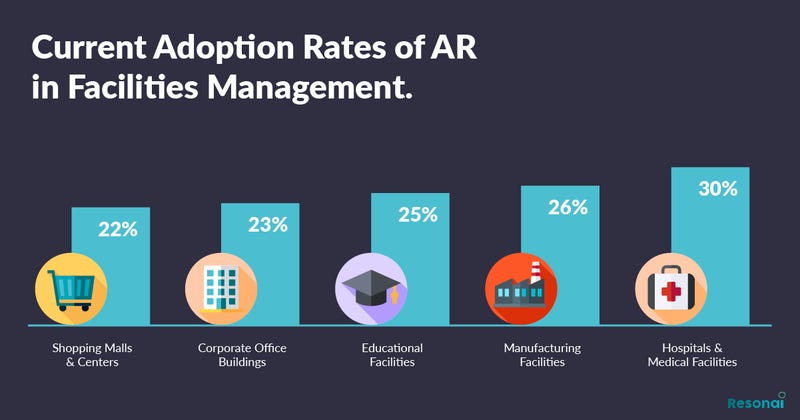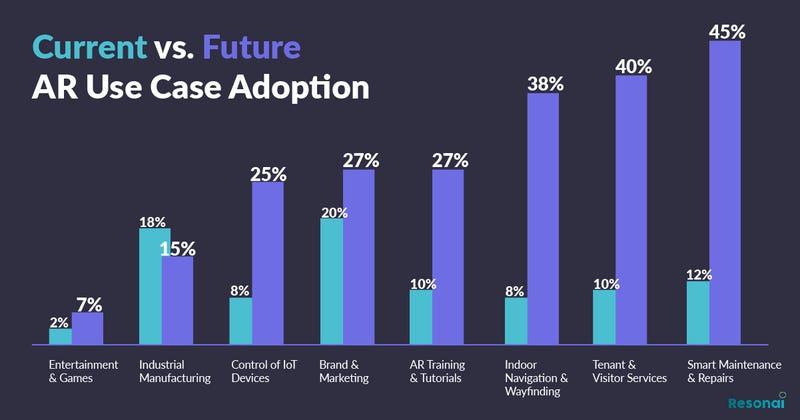Augmented Reality and Facilities: Smart Building Tech, Smart Machines Converge
Augmented reality is firmly embedded in the future of facilities management as smart building technology converges with smart devices and machines.
April 19, 2021

One out of five facilities management professionals use augmented reality (AR) for at least one function. Nearly three out of four of these managers who don’t currently use AR expects to implement the technology in the next 24 months. Resonai’s report, 2021 State of Augmented Reality in Facilities Management, explores the current and expected use of AR in corporate, retail, healthcare, and manufacturing facilities.
The report finds that:
At 30 percent adoption, hospitals and medical facilities have embraced AR more than other types of properties. They are followed by manufacturing facilities (26%), educational facilities (25%), and corporate offices (23%)
Facilities managers cited a broad range of benefits from AR, including the automation of maintenance processes (49%), prevention of maintenance issues (45%), reduction of physical contact during the COVID-19 pandemic (27%), creation of new revenue opportunities (27%), and insights derived from AR-based analytics (22%)
Seventy-five percent of facilities managers currently have IoT-enabled devices in their buildings, such as environment sensors (44%), HVAC systems (42%), security systems (33%), doors (25%), and lights (25%). AR can help manage the complexity that comes with these emerging technologies.
Common Use of AR in Facilities
The core of AR adoption in facilities is maintenance, but use cases are already stretching beyond that core. “In maintenance, we see the automation of reporting. When something is not working, it gets reported with AR technology,” Galia Rosen Schwarz, VP of business development at Resonai, told Design News. “Everything can be done automatically. You take a picture of it, and the picture will show your location and what object you’re looking at. That will produce a ticket and instructions for repair.”
As the medical industry rushes to adopt new technology, it’s not surprising AR is getting adopted rapidly at medical facilities. “One of our verticals is in healthcare. They’re already using AR. On the clinical side, there is the training of doctors and staff on how to use medical devices. Now that also includes the facility. No industry is close to medical on the use of AR,” said Schwarz. “You need to automate and document for people in the building. You need to locate devices that are moving around the hospital. There are ultrasound devices moving around the hospital. Medical facilities are big, and they have a big turnover, so internal navigation is a real challenge.”

AR is expanding into industrial settings as manufacturers go beyond automating the production line. “In industrial facilities, you’ll find augmented reality used for automation, repair, and preventive maintenance,” said Schwarz. “AR is also used for training on different equipment and machinery. It’s used for remote assistance for troubleshooting and repair.”
The Future of AR Is Convergence
According to the Resonai report, the use of AR will change over time. The uses in five or 10 years will be different than current uses. “When you look ahead, you see that emerging technology starts to work in concert. That includes AR glasses, robotics, everything a machine needs to understand its environment. It will be in one coordinated system,” said Schwarz. “We’ll see new devices that come with an advanced user experience. This will shift to personalized and location-based AR. Everything in the building will be smarter and more efficient.”

Schwarz noted that the perceived cost of deploying AR is greater than the actual cost. “One of the things we look at with perceived obstacles. The facility managers see the cost. That was the first barrier,” said Schwarz. “There is a big gap between the perceived cost and the actual cost. People don't understand how to use these platforms – so they see it as expensive – but it’s not.”
The pandemic prompted the adoption of automation technology in manufacturing. A similar trend has pushed AR adoption in facilities. “Until recently, the use of AR in facility maintenance was considered emerging, but that started to change during COVID-19 as people require more automation,” said Schwarz. “When they begin to replace manual tasks with automated tasks, they become more willing to deploy.”
Rob Spiegel has covered manufacturing for 19 years, 17 of them for Design News. Other topics he has covered include automation, supply chain technology, alternative energy, and cybersecurity. For 10 years, he was the owner and publisher of the food magazine Chile Pepper.
About the Author(s)
You May Also Like





